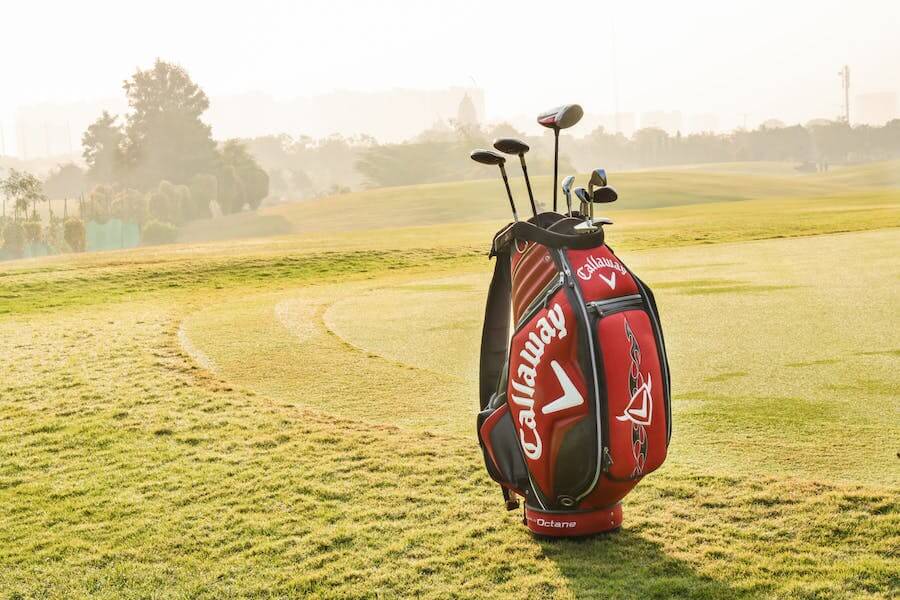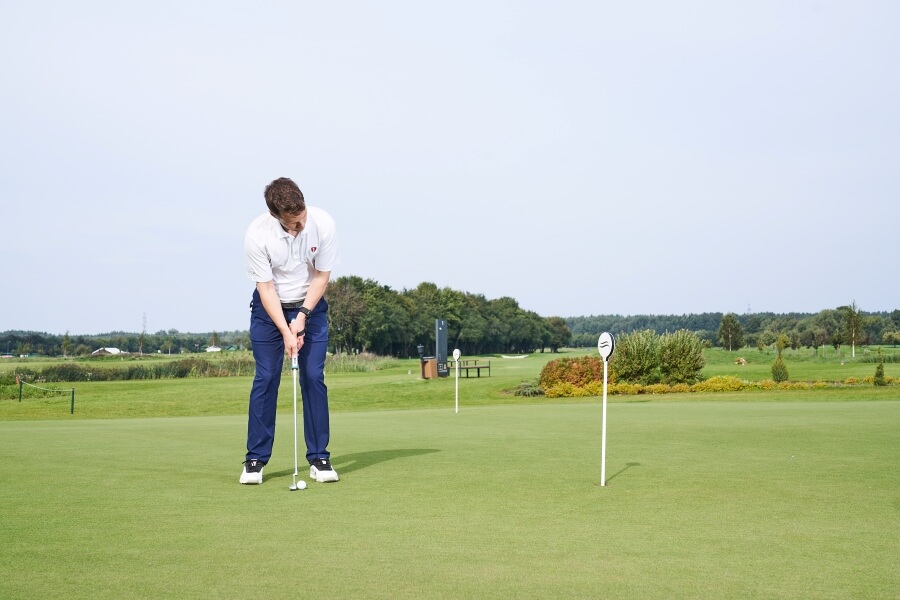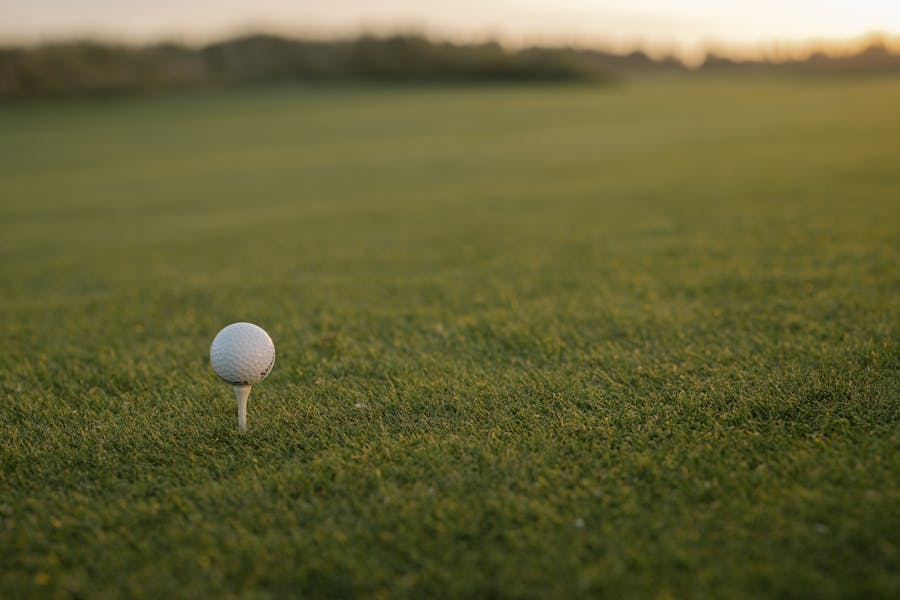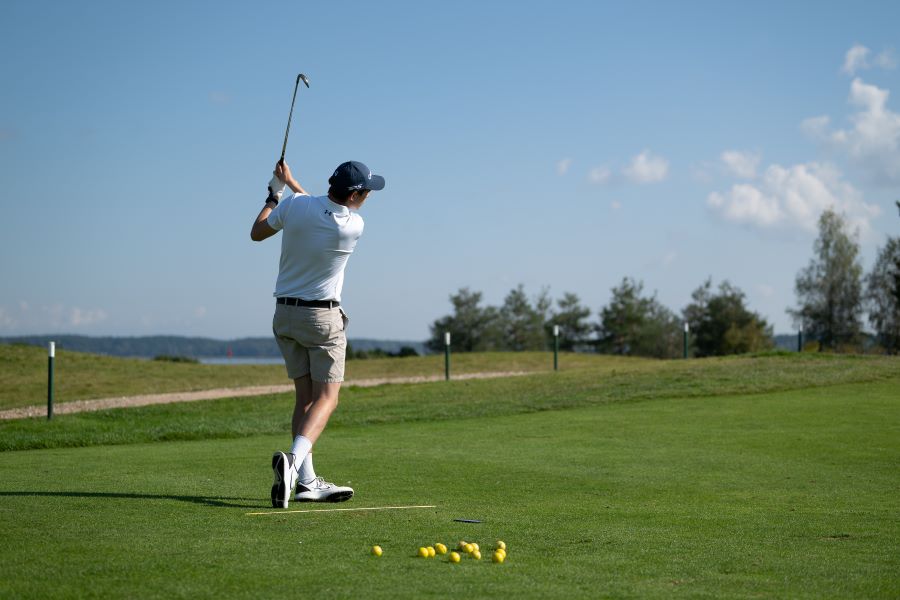How to Play Golf in the Wind: Complete Guide with Practical Tips & Drills
Golf is played outside, which means you’re always at the mercy of the elements. And no element messes with a golf ball more than the wind. Because the ball is so light, even a 10–15 mph breeze can change its flight dramatically.
The truth is, you’ll never beat the wind; you can only learn to manage it. That means controlling your launch, spin, and start lines so the breeze works with you, rather than against you.
In this guide, we’ll break down how wind really affects your shots and give you practical tips and drills to help you stay in control on your next breezy round.
Playing Golf in the Wind (Key Takeaways)
Here are a few of the most important points for playing golf in windy conditions.
- Don’t fight the wind—control launch, spin, and start line.
- Into-wind: more club, normal tempo, lower finish. Downwind: choose a higher start, land it shorter.
- Your wrists set dynamic loft and face angle. A slightly flexed lead wrist at impact lowers flight and kills “ballooning.”
- Read wind at multiple heights (flag, treetops, clouds) and plan your start lines, not your end points.
- Practice a “wind ladder” with one club: learn three stock trajectories and when to use each.
- Wear HackMotion to get instant feedback on lead-wrist flexion through impact so the ball launches lower when you need it.
Contents
How Much Does Wind Affect a Golf Ball?
We will start with an overview of how different wind conditions affect the flight of a golf ball.
From wind direction, including downwind, into the wind, and crosswinds, to wind speeds, all will have specific influences on the ball.
| Wind | Rule of Thumb | Example (150-yard shot) |
|---|---|---|
| Headwind | Add ~1 extra club per 10 mph | 20 mph = play it like 180 yds (hit 5-iron instead of 7-iron) |
| Downwind | Take ½–1 less club per 10 mph | 20 mph = plays ~135 yds (hit 8-iron instead of 7-iron) |
| Crosswind | Aim your start line into the wind; shape shots with it when possible | 20 mph right-to-left: aim right edge of green for a fade |
How to Adjust Your Setup for Windy Conditions
Your setup has more influence on ball flight than most golfers realize. A few small tweaks at the address can change launch, spin, and how the ball reacts in the breeze.
Here’s how to set yourself up for success:
Into the Wind (Low Flight)
This setup keeps the ball flight lower so it doesn’t balloon and lose distance.
- Ball position: move it slightly back in your stance.
- Tee height (with driver): tee it lower than normal.
- Grip: choke down ½ inch for more control.
- Weight: favor the lead side to encourage a downward strike.
Downwind (Use the Breeze)
This setup helps you launch the ball higher so the wind adds extra distance.
- Ball position: move it slightly forward.
- Spine tilt: exaggerate tilt away from the target (trail shoulder lower).
- Tee height: tee it higher to launch it up into the wind.
- Finish: allow a full, high finish to maximize carry.
Crosswind (Shape or Hold Your Line)
This setup makes it easier to either ride the wind or hold your shot against it.
- Ball position: keep it stock.
- Aim: align your body where you want the ball to start, and face where you want it to finish.
- Club selection: if shaping into the wind, take more club; if riding it, take less.
Swing Adjustments for Windy Conditions
The biggest mistake golfers make in the wind is swinging harder.
More speed means more spin, which causes the ball to balloon and lose control.
The goal is to swing with your normal tempo, or even a touch smoother, while letting setup and club choice do the heavy lifting.
Keep your swing compact. A slightly shorter backswing and a more controlled hand path help you maintain balance and strike the ball solidly. Solid contact matters more in the wind than almost anything else—you can’t afford thin or off-center strikes when the breeze is moving the ball.
Finally, focus on your finish. A lower, abbreviated finish flight keeps the ball down into the wind, while a full, high finish lets it ride downwind. Crosswinds are about committing to a start line and holding the face stable; don’t over-manipulate mid-swing.
| Key | Why It Works |
|---|---|
| Smooth tempo (no extra effort) | Reduces spin and keeps the ball from ballooning |
| Compact backswing | Improves contact and balance |
| Lower finish | Keeps trajectory down into headwinds |
| Higher finish | Launches ball higher to ride tailwinds |
| Commit to the start line | Lets crosswinds move the ball as planned |
If you want more control over ball flight in windy conditions, working with experienced golf coaches can help you master launch, spin, and trajectory management.
Wrist Adjustments: Controlling Launch in the Wind
Your wrists are the biggest influence on how the ball launches and spins. When the wind is up, that becomes even more important.
If your lead wrist is too extended (cupped) at impact, the club adds loft, creates extra spin, and the ball climbs higher, exactly what you don’t want into the wind.
Instead, you want a slightly flexed (bowed) lead wrist through impact. This keeps the dynamic loft down, reduces excess spin, and helps the ball cut through the breeze on a flatter, more penetrating flight.
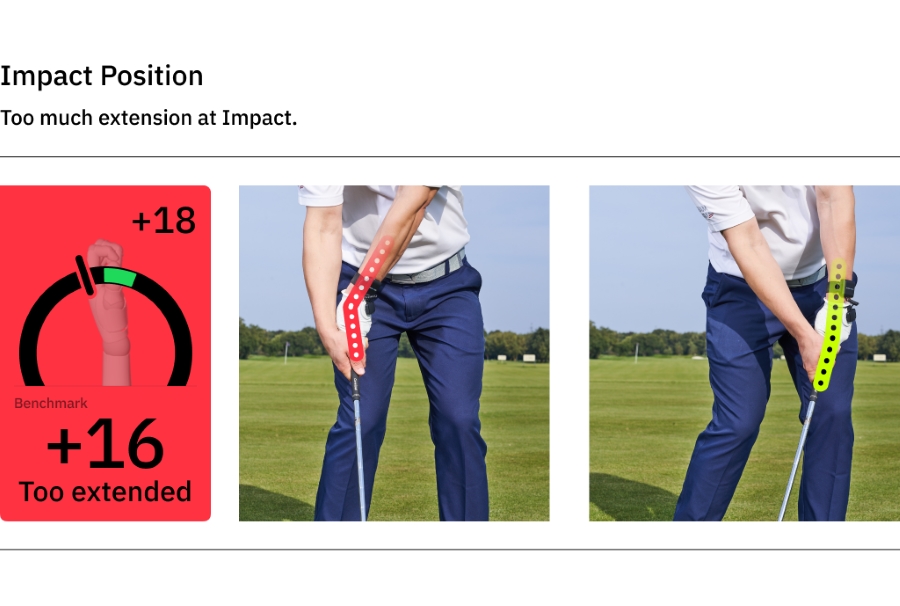
On the other hand, when you do want a higher shot (like riding a tailwind), allowing the wrist to stay a little more neutral or extended helps you launch it higher with less effort.
HackMotion makes this crystal clear by showing you the exact wrist angles at impact. With biofeedback, you can train yourself to feel when your lead wrist is in that stronger, flexed position that produces a lower, wind-beating trajectory.
Once you learn how much flexion works for you, it becomes a reliable tool, almost like having a built-in “trajectory control” knob in your swing.
Short Game Shots in Windy Conditions
The wind doesn’t just affect full swings; it plays a big role around the greens, too.
Because wedges launch the ball higher with more spin, the breeze exaggerates their flight. Learning how to adjust your short game saves a ton of strokes on blustery days.
- Flight it lower when you can. Use a less-lofted wedge (like a pitching wedge instead of a lob wedge) and keep the ball back in your stance. This produces a lower, more controlled shot that the wind can’t push around as easily.
- Play the rollout on downwind chips. Expect extra release when the wind is at your back. Land the ball shorter and let it run out.
- Use the wind as a backstop. Into the wind, you can be more aggressive—your shot will check up quickly after landing.
- Bunker shots go higher. A strong wind can either help stop the ball (into the wind) or make it race past the pin (downwind). Adjust your landing spot accordingly.
Tip: Practicing low-trajectory chips with HackMotion can help you learn the right wrist angles to keep the clubface stable and prevent flipping.
Putting in the Wind
Even on the green, the wind can move your ball. The key is to stay steady and adjust your pace.
In addition to these simple adjustments below make sure you don’t let the wind impact your mental game on the putting green.
Stick to your routine and make necessary adjustments but don’t let it derail your round.
- Set a solid base. Widen your stance a little if the wind is pushing you around.
- Into the wind: give the ball a firmer strike.
- Downwind: use a softer touch—the ball will roll out more.
- Crosswind: play a little extra break if the gusts are strong.
Drills for Windy Conditions
These HackMotion drills train the exact skills you need to keep the ball under control in the wind, lower launch, more solid contact, and a stable face.
Even when you feel out of control with the wind your wrists can put you back in charge.
Motorcycle Drill (Lower Ball Flight)
The Motorcycle Drill is one of the best ways to learn how to flight the ball down.
By training a slightly flexed lead wrist at impact, you’ll reduce dynamic loft, lower spin, and stop the ball from ballooning into a headwind. Practicing this drill with HackMotion gives you real-time feedback so you know you’re hitting the right wrist position every time.
HackMotion Motorcycle Drill – Step by Step
- Take your normal setup with a mid-iron.
- On the downswing, feel like you’re “revving a motorcycle” the lead wrist moves into slight flexion (bowed).
- With HackMotion, set biofeedback to signal when you maintain flexion through impact.
- Hold a lower finish and watch the ball fly flatter, ideal for headwinds.
Low Point Control Drill (Consistent Contact in the Breeze)
Wind exposes every mishit, so clean ball-first contact is critical. This drill helps you control low point and prevent fat or thin shots that the wind will exaggerate.
With HackMotion, you can see if your wrists are stable through impact or if flipping is causing inconsistent strikes.
Low Point Control Drill – Step by Step
- Place a line or tee just ahead of the ball. If you have the ability, drawing a line you can work with on the range is rather helpful.
- Focus on striking ball first, then the ground.
- Use HackMotion to monitor your lead wrist staying stable through impact (no early extension or flipping).
- Clean, consistent strikes hold up much better in crosswinds and headwinds.
Release Drill (Face Stability in Crosswinds)
Crosswinds can make a small miss with the face turn into a big miss. The Release Drill teaches you to stabilize the face through impact so your ball doesn’t over-curve.
Using HackMotion, you’ll see exactly how much your wrist is extending or flexing and learn how to quiet the hands for straighter shots.
Perfect Your Release with HackMotion
Fine-tune your release for consistent contact. Start with a short swing to master control before adding power.
HackMotion Release Drill – Step by Step
- Hit half-swing shots focusing on rotating your body while keeping the wrists quiet.
- With HackMotion, track how much lead wrist extension/flexion you’re using through release.
- The goal: limit unwanted extension so the face stays square longer.
- Build up to full swings with the same controlled release.
FAQ’s
How much does wind affect a golf ball?
The wind can have a dramatic effect on the golf ball in flight. It is one of the most significant external influences in golf. Not paying close attention to the wind and its influence could mean much higher scores.
Can you play golf in 20 mph wind?
Although challenging, you can play golf in winds of 20 mph. You have to understand how the wind can affect the ball and have a good plan of attack on how to battle it. Of course, proper execution means everything.
When is it too windy for golf?
In tournament play, it can indeed get too windy to continue play. One of the most significant indicators is when a ball does not stay in place on the putting green.
It has happened numerous times on the PGA Tour. In February 2023, in the third round of the AT&T Pebble Beach Pro-Am, play was paused at 12:20 p.m. due to high winds. By 2:48 p.m., play for the day was called as conditions did not improve.
Final Thoughts
Few things can disrupt a round of golf like the wind. It’s an element you can’t control, but you can learn to manage it.
The key is understanding how wind changes ball flight and having a plan before you swing. With the right setup adjustments, swing keys, and wrist control, you can turn blustery conditions into an opportunity instead of a frustration.
Practice these shots ahead of time so when the wind shows up, you’re ready to trust your adjustments and play with confidence.






